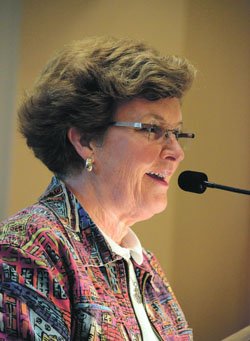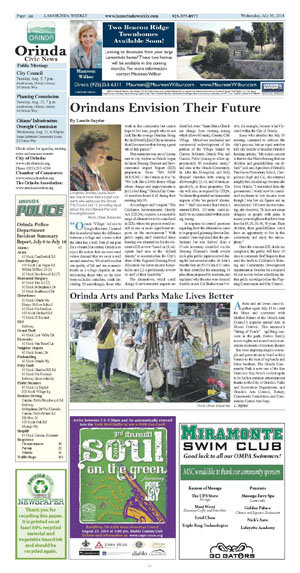|
|
Published July 30th, 2014
|
Orindans Envision Their Future
|
|
| By Laurie Snyder |
 |
| Longtime Orindan, Laurie Reich, was one of more than a dozen residents who addressed the Orinda City Council July 15, providing input about the city's General Plan and Housing Element. Photo Ohlen Alexander |
"Orinda 'Village' led me to Google this term. I learned that in medieval times the difference between a village and a town is that the latter has a wall. Part of our plan for a vibrant 21st century Orinda is to reject the notion that our semi-rural values demand that we erect a wall around ourselves. We should see that our quality of life and our economic health as a village depends on our welcoming those who so far have been excluded: outsiders, youth (including 20-somethings), those who work in this community but cannot hope to live here, people who do not look like the average Orindan. Being the 2nd Friendly [sic] City in America should mean more than having a great 4th of July parade."
 That statement was one of dozens sent to city leaders as Orinda began its latest Housing Element and Environmental Impact Report (EIR) preparation. From "NO NEW HOUSING. I like Orinda as it is," to "We look like a 1960s theme village where change and improvements is [sic] a bad thing," Orinda City Council members heard it all during their meeting July 15.
That statement was one of dozens sent to city leaders as Orinda began its latest Housing Element and Environmental Impact Report (EIR) preparation. From "NO NEW HOUSING. I like Orinda as it is," to "We look like a 1960s theme village where change and improvements is [sic] a bad thing," Orinda City Council members heard it all during their meeting July 15.
 According to staff's report, "The California Environmental Quality Act (CEQA) requires a reasonable range of alternatives to be considered in EIRs where the project would result in one or more significant impacts on the environment." With public input, staff identified three housing site alternatives for the element's EIR review "based on (1) adequate land area at the 'default density' to accommodate the City's share of the Regional Housing Need Allocation for lower income households and (2) a preliminary review by staff of their feasibility."
According to staff's report, "The California Environmental Quality Act (CEQA) requires a reasonable range of alternatives to be considered in EIRs where the project would result in one or more significant impacts on the environment." With public input, staff identified three housing site alternatives for the element's EIR review "based on (1) adequate land area at the 'default density' to accommodate the City's share of the Regional Housing Need Allocation for lower income households and (2) a preliminary review by staff of their feasibility."
 The alternatives, which could change if environmental impacts are identified, were: "Santa Maria Church (no change from existing zoning which allows 80 units), Country Club Village - Mixed-use residential and commercial redevelopment of the portion of the Village bound by Camino Sobrante, Orinda Way and Camino Pablo (zoning to allow approximately 80 residential units)," and sites at the Orinda Community, St. John the Evangelist, and Holy Shepard churches with zoning to allow roughly 22, 42, and 16 units, respectively, at those properties. The city will also, as required by CEQA, "evaluate the potential environmental impacts of the 'no project' alternative.'" Staff also noted that Orinda's current RHNA - 227 units - could actually be accommodated within existing zoning.
The alternatives, which could change if environmental impacts are identified, were: "Santa Maria Church (no change from existing zoning which allows 80 units), Country Club Village - Mixed-use residential and commercial redevelopment of the portion of the Village bound by Camino Sobrante, Orinda Way and Camino Pablo (zoning to allow approximately 80 residential units)," and sites at the Orinda Community, St. John the Evangelist, and Holy Shepard churches with zoning to allow roughly 22, 42, and 16 units, respectively, at those properties. The city will also, as required by CEQA, "evaluate the potential environmental impacts of the 'no project' alternative.'" Staff also noted that Orinda's current RHNA - 227 units - could actually be accommodated within existing zoning.
 In response to council questions regarding how the alternatives came to be proposed, planning director Emmanuel Ursu explained that the preliminary list was derived from a 17-site inventory identified via the Housing Element's fourth review cycle plus public input received during the last several months. St. John's was the first on 2013's list of 17 sites. He then identified the remaining 16 plus others proposed by residents, and explained why the sites were deemed feasible or not. Cal Shakes wasn't viable, for example, because it isn't located within the City of Orinda.
In response to council questions regarding how the alternatives came to be proposed, planning director Emmanuel Ursu explained that the preliminary list was derived from a 17-site inventory identified via the Housing Element's fourth review cycle plus public input received during the last several months. St. John's was the first on 2013's list of 17 sites. He then identified the remaining 16 plus others proposed by residents, and explained why the sites were deemed feasible or not. Cal Shakes wasn't viable, for example, because it isn't located within the City of Orinda.
 Some who attended the July 15 meeting continued to criticize the city's process, but an equal number told city leaders to broaden Orinda's housing options. "My major concern is that we don't have housing that our children and grandchildren can afford," said one. A product of Orinda's Pine Grove Elementary School, Campolindo High and Cal, she returned roughly two decades ago because she loves Orinda. "I just retired from the government. I would now be considered moderate to low income even though I was low six figures and an area director." Of lower income housing, she observed, "It does not mean druggies or people with guns. It means your neighbors that have been here for 19, 20, 30, 40, 50 years. Their children, their grandchildren could have an opportunity to live in this community and enjoy the atmosphere."
Some who attended the July 15 meeting continued to criticize the city's process, but an equal number told city leaders to broaden Orinda's housing options. "My major concern is that we don't have housing that our children and grandchildren can afford," said one. A product of Orinda's Pine Grove Elementary School, Campolindo High and Cal, she returned roughly two decades ago because she loves Orinda. "I just retired from the government. I would now be considered moderate to low income even though I was low six figures and an area director." Of lower income housing, she observed, "It does not mean druggies or people with guns. It means your neighbors that have been here for 19, 20, 30, 40, 50 years. Their children, their grandchildren could have an opportunity to live in this community and enjoy the atmosphere."
 Once the element-EIR drafts are completed, the public will have 45 days to comment. Staff hopes to then send the drafts to California's Housing and Community Development department in October for a required 60-day review before scheduling further public meetings before the Planning Commission and City Council.
Once the element-EIR drafts are completed, the public will have 45 days to comment. Staff hopes to then send the drafts to California's Housing and Community Development department in October for a required 60-day review before scheduling further public meetings before the Planning Commission and City Council.

|
|
|
|
|
|
|
|
|
| |
|
|
|
|



